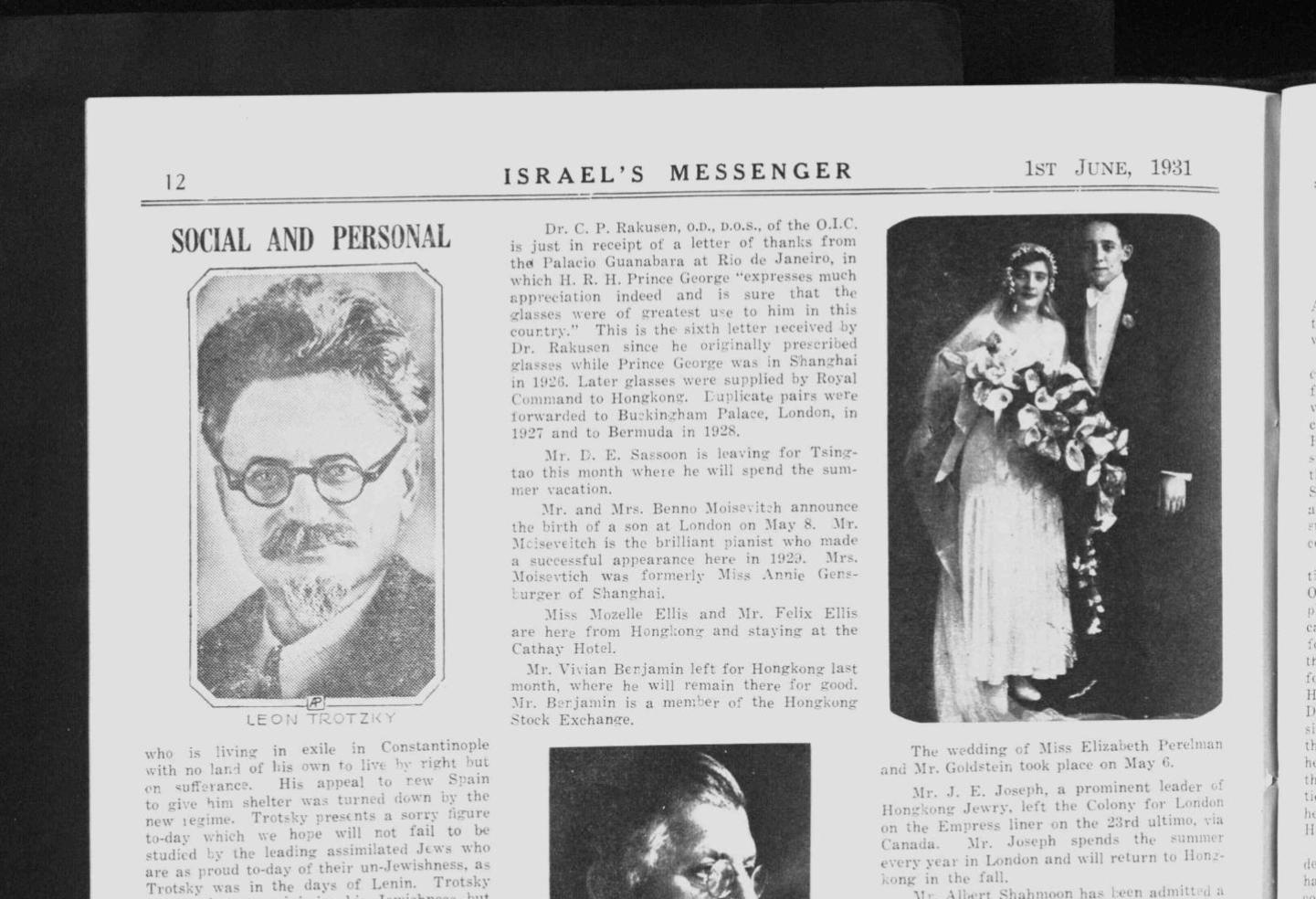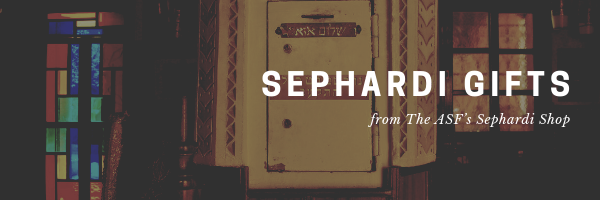Trotsky, Shanghai, and Today’s Jewish Identity Crisis

In Memory of Ralph de Toledano, a Tangier-born Moroccan-Sephardi author, scion of a Spanish-Sephardi rabbinic family, journalist, jazz aficionado, and political activist, who got his start in New York’s intellectual scene as youth leader of the Socialist Party of America’s “Old Guard” anti-communist faction and later as editor of the Party’s organ, The New Leader. The ASF is home to a collection of Toledano’s books, including his 1574 edition of Yosef Caro’s Shulchan Aruch printed at Venice.
Click here to dedicate a future issue in honor or memory of a loved one

Upcoming Events ◊ ASF Sephardi Shop ◊ Sephardi World Weekly ◊ ASF IJE ◊ ASF Sephardi House ◊ Archive◊ Donate
The American Sephardi Federation’s Sephardi Ideas Monthly (SIM) is a continuing series of essays and interviews by Dr. Aryeh Tepper from the rich, multi-dimensional world of Sephardi thought and culture that is delivered to your inbox every month.
————————————
The penultimate installment of Sephardi Ideas Monthly’s tour through Jewish life in South and East Asia pauses to note the appearance of an unexpected guest in the “Social and Personal” pages of Israel’s Messenger (1904-41), the English-language newspaper of Shanghai’s Baghdadi Jewish community: Leon Trotsky. How did the Marxist revolutionary get lumped together with the latest news about births, deaths, weddings, bar-mitzvah celebrations, and new arrivals to and departures from Baghdadi-Jewish Shanghai?
In 1931, the Jewish leader of the early Bolshevik movement, Lev Davidovich Bronstein, aka, Leon Trotsky (1879-1940), was living as a political exile from the Soviet Union in Turkey. It was part of his journey from a wealthy, assimilated Ukrainian-Jewish family to serving as Vladmir Lenin’s Russified right-hand man to death in Mexico City at the hands of an assassin sent by Josef Stalin in 1940. The wound, which Trotsky survived for a day, was an ice-pick to the brain. Bizarrely, even during his final years, as reality mocked the totalitarian-utopian dreams that ultimately led him to a violent dead end, Trotsky remained a believer in the communist future.
In 1931, the editor of Israel’s Messenger (IM) and Trotsky’s contemporary, N.E.B. Ezra (1883-1936), was using IM as a vehicle for establishing Zionist diplomacy in the Far East while augmenting voices from the Classic Sephardic tradition, such as Rabbi Dr. Ariel Bension and Rabbi Ben-Tzion Meir Hai Uziel. After observing Trotsky fleeing from the totalitarian state he helped to build and his failure to secure asylum in Spain (as well as Belgium, France, Norway, Germany, and the United Kingdom), Ezra decided to use the latest news of Trotsky’s Turkish exile as a humorous, teachable moment.
Leon Trotsky appeared sixteen times in the pages of Israel’s Messenger during the interwar period of 1921 – 1936, the year of Ezra’s passing. The consistently negative references increased in number as the political temperature heated up in Europe and around the globe. Ezra was an ardent Zionist deeply rooted in the Jewish tradition and in the Baghdadi Jewish networks across South and East Asia that benefited from the freedoms and opportunities created by British rule; it is easy to understand how Trotsky the thoroughly assimilated, atheistic communist got on Ezra’s nerves.
The first reference to Trotsky in Israel’s Messenger set the tone for what followed thereafter. In April, 1921, Ezra republished a sermon originally offered by New Jersey-based Rabbi Jacob Goldstein, “Henry Ford, the Modern Haman.” Henry Ford the “America First” antisemite claimed that Jews “own Soviet Russia – because Trotsky is a Jew.” Goldstein’s response: “Trotsky is a Jew whom no Jew I ever met desires to claim as a brother.”
Sometimes Ezra would feature a writer who refuted the alleged connection between Bolshevism and Zionism; another contributor blamed Trotsky for turning Russia into “shambles.” In his own voice Ezra stated that “Bolshevism is not Jewish. Bolshevism and Judaism are as far apart from each other as are the two poles. Judaism is the most outspoken, the most direct negation of Bolshevism” while “Trotsky is a creature of his own country; our race cannot be held responsible for men such as these.”

A scan of Israel’s Messenger, 1 June 1931
So, in 1931, after Trotsky’s request for Spanish asylum had been refused, Ezra saw an opportunity. In the June issue of IM, together with news that “Miss Mozelle Ellis and Mr. Felix Ellis are here from Hongkong [sic] and staying at the Cathay Hotel” and notice of a Chinese Women’s Club lecture offered by Dr. Magnus Hirschfeld, “authority on sexology,” Ezra opened IM’s “Social and Personal” page a with large profile photo of Trotsky in his round-rim glasses and Van Dyke goatee with the news that “Leon Trotsky… is living in Constantinople with no land of his own to live by right but en sufferance. His appeal to new Spain to give him shelter was turned down by the new regime.”
Zionist-point made. In case there was any confusion, Ezra added the general lesson:
Trotsky presents a sorry figure to-day which we hope will not fail to be studied by the leading assimilated Jews who are as proud to-day of their un-Jewishness, as Trotsky was in the days of Lenin. Trotsky did his best to minimize his Jewishness but the world emphasized it and would not let him go the way he wants.
And if this was not sufficiently clear, Ezra concluded by declaring Trotsky’s life “a tragedy!” In using the term “tragedy,” Ezra did not intend to express sympathy for the wandering communist, but to transform his pitiful condition into a general warning about the fate of assimilated Jews who reject Zionism and identify with the far left.
The world changed after Hamas’ brutal attack on Oct. 7th. While the lionization of Hitler on the “populist” right might not come as a surprise, who predicted the rise of a pro-Hamas “progressive” left?
But in some ways, it’s an old story. The far left has always hated the West, and keffiyeh-wearing Jews in support of Hamas are Leon Trotsky’s Jewish spiritual great-grandchildren. While we pray that these lost Jewish souls can be awakened to the reality of Islamist terror, Trotsky’s example demonstrates how deep the denial of reality can go.
N.E.B. Ezra’s 1931 entry on Leon Trotsky in the “Social and Personal” pages of Israel’s Messenger was a funny joke. It remains a strangely relevant warning.
~~~~~~~

Rav Haim David HaLevi: An Underappreciated Sephardic Gadol
By Rabbi Haim Jachter, Jewish Link of New Jersey
Hakham Rav Haim David HaLevi (1924-1998) was a prodigious scholar and original thinker who served as the Chief Rabbi of Tel Aviv and composed texts that appealed to both religious and academic scholars, as well as the general public. However, “[m]ention the name of Rav Haim David HaLevi to even knowledgeable Sephardic Jews and many will say they never heard of him!” Rabbi Haim Jachter introduces us to a 20th century Sephardi luminary whose impact was immense, but often overlooked: “Rav HaLevi is regarded as the first posek of note to formally and officially declare that smoking is forbidden according to the Halacha… Rav HaLevi set the mold, and by the 2000s nearly every rabbi of major stature has declared smoking to be forbidden.”
On Being a Jew: What does it Mean to be a Jew: A Conversation about Judaism and its Practice in Today’s World
By James Kugel
Composed as a meandering dialogue between a wily Syrian-Jewish banker and an American graduate student of literature, this engaging book explains all the basic beliefs and practices of Judaism―Jewish teachings on intermarriage and conversion, keeping the Sabbath, prayer and Torah, midrash and mitzvot, and God’s presence in the world. Although the book has plenty of the “how to” of religious practice, Being a Jew is in the end an eloquent reflection on Judaism’s deepest theme: living life as a way of serving God.
~~~~~~~
Upcoming Events or Opportunities
The American Sephardi Community will Stand Together: Unity, Strength, Resilience

Sunday, 10 November, 3:00PM
Washington, D.C.
Gates Open at 12PM; Pre-Show Starts at 1PM
The American Sephardi Federation, as the Sephardic Voice in the Conference of Presidents of Major American Jewish Organizations, is proud to once again be joining forces with the Jewish Federations of North America and other organizations gathering in Washington, D.C. to reaffirm shard American values, support for Israel, and to strengthen Jewish unity and resilience. Apply to join the official American Sephardi Community delegation to Stand Together.
Sign-up Now!
~~~~~~~
The Combat Antisemitism Movement, Jazz Leadership Project, and American Sephardi Federation present:
American Excellence
The Omni-American Future Gala
Join us for a night of inspiration, music, and excellence honoring
Roy Niederhoffer
and
Emmet Cohen.
Experience an evening of world-class jazz music by Coleman Hughes and Itamar Borochov performing with The Emmet Cohen Trio.

Tuesday, 12 November
Cocktail Reception
6:00-7:00PM ET
Dinner & Program
7:00-9:00PM ET
@Ginny’s Supper Club in Harlem
310 Lenox Ave. NYC
Sign-up Now!
Tickets: $45-$500
The Omni-American Future Project, rooted in the intellectual legacies of Albert Murray and Ralph Ellison, fights bigotry, advances cultural excellence via the example of jazz music, and strives to strengthen the American civic center. We counter extremism and division by fostering unity, inclusion, and shared values. A revitalized Black American and Jewish American alliance is at the core of our initiative. Past Albert Murray and Young Leader Award honorees include Professor Danielle Allen (Director of the Edmond & Lily Safra Center for Ethics at Harvard), writer and musician Coleman Hughes, Jazz at Lincoln Center’s Wynton Marsalis, and US Representative Ritchie Torres. Click here to learn about past Omni-American Project events.
~~~~~~~
The Grad Network of Columbia/Barnard Hillel, Moishe House Harlem, and the American Sephardi Federarion’s Sephardi House Initiative for Young Professionals present:
Ritual Lab Workshop
Hebrew & Arabic Calligraphy
Learn about Arabic, Hebrew, and Persian language and participate in a
hands-on calligraphy workshop!
Are you a young professionals in your 20s?
Join us as we dive into the rich visual worlds of Arabic, Hebrew and Persian calligraphy. Through historical, spiritual, linguistic and artistic lenses, we will discover the parallels between these languages. Educator, community builder, and artist Ruben Shimonov will also take us on an exploratory journey of his own multilingual calligraphy—sharing the ways he has used his art to celebrate the cultural diversity of the Greater Sephardi world.

Thursday, 14 November at 7:00PM
Space is limited. Register to reserve your materials.
@at Harlem Moishe House
(The address will be shared will all registrants closer to the date of the program).
Sign-up Now!
(Registration Required)
*If cost is a barrier to participation, please email Melissa, Director of The Grad Network.
About the Speaker:
Ruben Shimonov is an educator, community builder, and social entrepreneur with a passion for Jewish diversity. He previously served as Director of Community Engagement and Education at Queens College Hillel. Currently, Ruben is the American Sephardi Federation’s National Director of Sephardi House and Young Leadership. He is also the Founding Executive Director of the Sephardic Mizrahi Q Network and Director of Educational Experiences & Programming for the Muslim-Jewish Solidarity Committee. He is an alumnus of the COJECO Blueprint, Nahum Goldmann and ASF Broome & Allen Fellowships for his work in Jewish social innovation and Sephardic scholarship. He has been listed among The Jewish Week’s “36 Under 36” Jewish community leaders and changemakers. Currently, he is a Jewish Pedagogies Research Fellow at M² | The Institute of Experiential Jewish Education. Ruben has lectured extensively on the histories and cultures of various Sephardic and Mizrahi communities. He is also a visual artist specializing in multilingual calligraphy that interweaves Arabic, Hebrew, and Persian.
~~~~~~~
Museum of the Bible presents:
The Afghan Liturgical Quire Speaker Series
Join us for a special speaker series to explore the oldest Hebrew codex in the world and discuss three major topics related to the Afghan Liturgical Quire (ALQ) with museum curators, leading scholars, and influential leaders in the Afghan Jewish community.
Speakers include but are not limited to Jason Guberman (ED of American Sephardi Federation), Dr. Ruth Langer (Boston College), and Sara Aharon (author)

Sunday, 17 November at 3:30PM
Sign-up in-person!
Tickets: $24.99-$29.99
Sign-up on Zoom!
Tickets: $4.99-$9.99
These lectures will be held at the museum and on Zoom. Tickets for the event include general admission to the museum for those who want to see the Afghan Liturgical Quire on exhibit.
~~~~~~~
The ASF proudly promotes this event by the New York Andalus Ensemble, in conjunction with the Foundation of Iberian Music and La Nacional:
Ya Qalbi (Oh Heart!)
An evening of music and song from al-Andalus and North Africa
For five hundred years, Christians, Jews, and Muslims lived side by side in Medieval Iberia, sharing their arts and sciences to create a scintillating, multicultural tradition of music and poetry. Singing in Arabic, Hebrew, and Ladino to reflect this cultural pluralism, ASF Broome & Allen Fellow Dr. Sam Torjman Thomas’ New York Andalus Ensemble presents spiritual texts and songs of love and everyday life in Al-Andalus, emphasizing the expressive quality of the region’s shared tradition even as it respects the individual cultures that comprise it. Meticulous attention is paid to authenticity of style and pronunciation as ensemble members, hailing from Algeria, Syria, Israel, Morocco, and the United States, pool their linguistic and musical expertise.
“You won’t want to miss the chance to see such a diverse and versatile group.” —Spain Culture, New York

Wednesday, 20 November at 7:30PM
@La Nacional, Spanish Benevolent Society
239 W 14th St, New York City
Sign-up Now!
Tickets: $18-$24
ASF Members are eligible to 10% Off with the promo code (ASF)
Doors Open at 6:45pm; Concert starts at 7:30pm. If you’re interested in the restaurant downstairs, it is highly recommended you make a reservation.